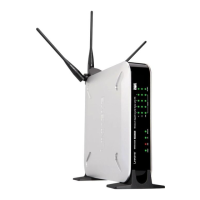assigned it will always have that same IP address until you change it. Static IP addresses are commonly
used with dedicated network devices such as server PCs or print servers. Since a user’s PC is moving
around in a network and is being powered on or off, it does not require a dedicated IP address that could be
a precious resource in your network.
If you use the Router to share your cable or DSL Internet connection, contact your ISP to find out if
they have assigned a static IP address to your account. If so, you will need that static IP address when
configuring the Router. You can get the information from your ISP.
A dynamic IP address is automatically assigned to a device on the network. This IP address is called
dynamic because it is only temporarily assigned to the PC or other device. After a certain time period, it
expires and may change. If a PC logs onto the network (or the Internet) and its dynamic IP address has
expired, the DHCP server will assign it a new dynamic IP address. Most ISPs use dynamic IP addresses for
their customers. By default, the Router’s Internet Connection Type is Obtain an IP automatically
(DHCP).
For DSL users, many ISPs may require you to log on with a user name and password to gain access to the
Internet. This is a dedicated, high-speed connection type called Point-to-Point Protocol over Ethernet
(PPPoE). PPPoE is similar to a dial-up connection, which establishes a PPP session with an ISP server
through the DSL connection. The server will also provide the Router with a dynamic IP address to
establish a connection to the Internet.
A DHCP server can either be located on a designated PC on the network or another network device, such as
the Router. The PC or network device obtaining an IP address is called the DHCP client. DHCP frees you
from having to assign IP addresses manually every time a new user is added to your network. For this
Wireless-N Router, a DHCP client is running on a WAN port for most configurations. A DHCP server is
running on the LAN side to provide services.
By default, a DHCP server is enabled on the Router. If you already have a DHCP server running on your
network, you MUST disable one of the two DHCP servers. If you run more than one DHCP server on your
network, you will experience network errors, such as conflicting IP addresses. To disable DHCP on the
Router, refer to the Basic Setup section in “Chapter 6: Setting Up and Configuring the Router.”
Static IP address: a fixed address assigned to a computer or device that is connected to a network.
Dynamic IP address: a temporary IP address assigned by a DHCP server.
DHCP (Dynamic Host Configuration Protocol): a protocol that lets one device on a local network, known
as a DHCP server, assign temporary IP addresses to the other network devices, typically computers.

